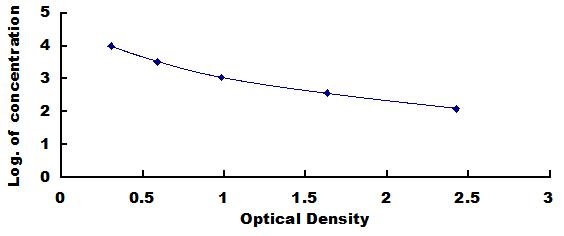Packages (Simulation)

Reagent Preparation

Image (I)
Image (II)
Certificate


ELISA Kit for Claudin 3 (CLDN3)
C7orf1; CPE-R2; CPETR2; HRVP1; RVP1; Clostridium Perfringens Enterotoxin Receptor 2; Ventral Prostate.1-Like Protein; CPE-Receptor 2
- Product No.CEF293Ca
- Organism SpeciesCanis familiaris; Canine (Dog) Same name, Different species.
- Sample Typeserum, plasma, tissue homogenates, cell lysates, cell culture supernates and other biological fluids
- Test MethodCompetitive Inhibition
- Assay Length2h
- Detection Range123.5-10,000pg/mL
- SensitivityThe minimum detectable dose of this kit is typically less than 52.4pg/mL.
- DownloadInstruction Manual
- UOM 48T96T 96T*5 96T*10 96T*100
- FOB
US$ 560
US$ 800
US$ 3600
US$ 6800
US$ 56000
For more details, please contact local distributors!
Specificity
This assay has high sensitivity and excellent specificity for detection of Claudin 3 (CLDN3).
No significant cross-reactivity or interference between Claudin 3 (CLDN3) and analogues was observed.
Recovery
Matrices listed below were spiked with certain level of recombinant Claudin 3 (CLDN3) and the recovery rates were calculated by comparing the measured value to the expected amount of Claudin 3 (CLDN3) in samples.
| Matrix | Recovery range (%) | Average(%) |
| serum(n=5) | 96-103 | 101 |
| EDTA plasma(n=5) | 78-92 | 88 |
| heparin plasma(n=5) | 90-104 | 101 |
Precision
Intra-assay Precision (Precision within an assay): 3 samples with low, middle and high level Claudin 3 (CLDN3) were tested 20 times on one plate, respectively.
Inter-assay Precision (Precision between assays): 3 samples with low, middle and high level Claudin 3 (CLDN3) were tested on 3 different plates, 8 replicates in each plate.
CV(%) = SD/meanX100
Intra-Assay: CV<10%
Inter-Assay: CV<12%
Linearity
The linearity of the kit was assayed by testing samples spiked with appropriate concentration of Claudin 3 (CLDN3) and their serial dilutions. The results were demonstrated by the percentage of calculated concentration to the expected.
| Sample | 1:2 | 1:4 | 1:8 | 1:16 |
| serum(n=5) | 79-89% | 81-94% | 99-105% | 80-103% |
| EDTA plasma(n=5) | 97-105% | 86-104% | 90-97% | 89-103% |
| heparin plasma(n=5) | 93-102% | 78-98% | 80-92% | 87-94% |
Stability
The stability of kit is determined by the loss rate of activity. The loss rate of this kit is less than 5% within the expiration date under appropriate storage condition.
To minimize extra influence on the performance, operation procedures and lab conditions, especially room temperature, air humidity, incubator temperature should be strictly controlled. It is also strongly suggested that the whole assay is performed by the same operator from the beginning to the end.
Reagents and materials provided
| Reagents | Quantity | Reagents | Quantity |
| Pre-coated, ready to use 96-well strip plate | 1 | Plate sealer for 96 wells | 4 |
| Standard | 2 | Standard Diluent | 1×20mL |
| Detection Reagent A | 1×120µL | Assay Diluent A | 1×12mL |
| Detection Reagent B | 1×120µL | Assay Diluent B | 1×12mL |
| TMB Substrate | 1×9mL | Stop Solution | 1×6mL |
| Wash Buffer (30 × concentrate) | 1×20mL | Instruction manual | 1 |
Assay procedure summary
1. Prepare all reagents, samples and standards;
2. Add 50µL standard or sample to each well.
And then add 50µL prepared Detection Reagent A immediately.
Shake and mix. Incubate 1 hour at 37°C;
3. Aspirate and wash 3 times;
4. Add 100µL prepared Detection Reagent B. Incubate 30 minutes at 37°C;
5. Aspirate and wash 5 times;
6. Add 90µL Substrate Solution. Incubate 10-20 minutes at 37°C;
7. Add 50µL Stop Solution. Read at 450 nm immediately.
GIVEAWAYS
INCREMENT SERVICES
| Magazine | Citations |
| Eur J Appl Physiol | Gastrointestinal response and endotoxemia during intense exercise in hot and cool environments Pubmed: 23314685 |
| European Journal of Applied Physiology | Effects of probiotics supplementation on gastrointestinal permeability, inflammation and exercise performance in the heat Springer: Source |
| Pediatr Crit Care Med | Clinical Characteristics Associated With Postoperative Intestinal Epithelial Barrier Dysfunction in Children With Congenital Heart Disease* PubMed: 25162512 |
| Clinical Nutrition | Reinforcement of intestinal epithelial barrier by arabinoxylans in overweight and obese subjects: A randomized controlled trial: Arabinoxylans in gut barrier. pubmed:28214040 |
| Clinics and Research in Hepatology and Gastroenterology | Plasma claudin-3 is associated with tumor necrosis factor-alpha-induced intestinal endotoxemia in liver disease Pubmed: 31053499 |
| Nutrients | Intestinal Permeability in Children with Celiac Disease after the Administration of Oligofructose-Enriched Inulin into a Gluten-Free Diet—Results of a Randomized … Pubmed: 32531982 |
| Journal of Exercise Physiology Online | Markers of Intestinal Damage in Individuals with and without Obesity during a 12-Week Exercise Period. |
| JACC: Basic to Translational Science | Dysbiosis and Intestinal Barrier Dysfunction in Pediatric Congenital Heart Disease is Exacerbated Following Cardiopulmonary Bypass |
| Nutrients | Short-Term Very High Carbohydrate Diet and Gut-Training Have Minor Effects on Gastrointestinal Status and Performance in Highly Trained Endurance Athletes Pubmed:35565896 |
| Catalog No. | Related products for research use of Canis familiaris; Canine (Dog) Organism species | Applications (RESEARCH USE ONLY!) |
| CEF293Ca | ELISA Kit for Claudin 3 (CLDN3) | Enzyme-linked immunosorbent assay for Antigen Detection. |















